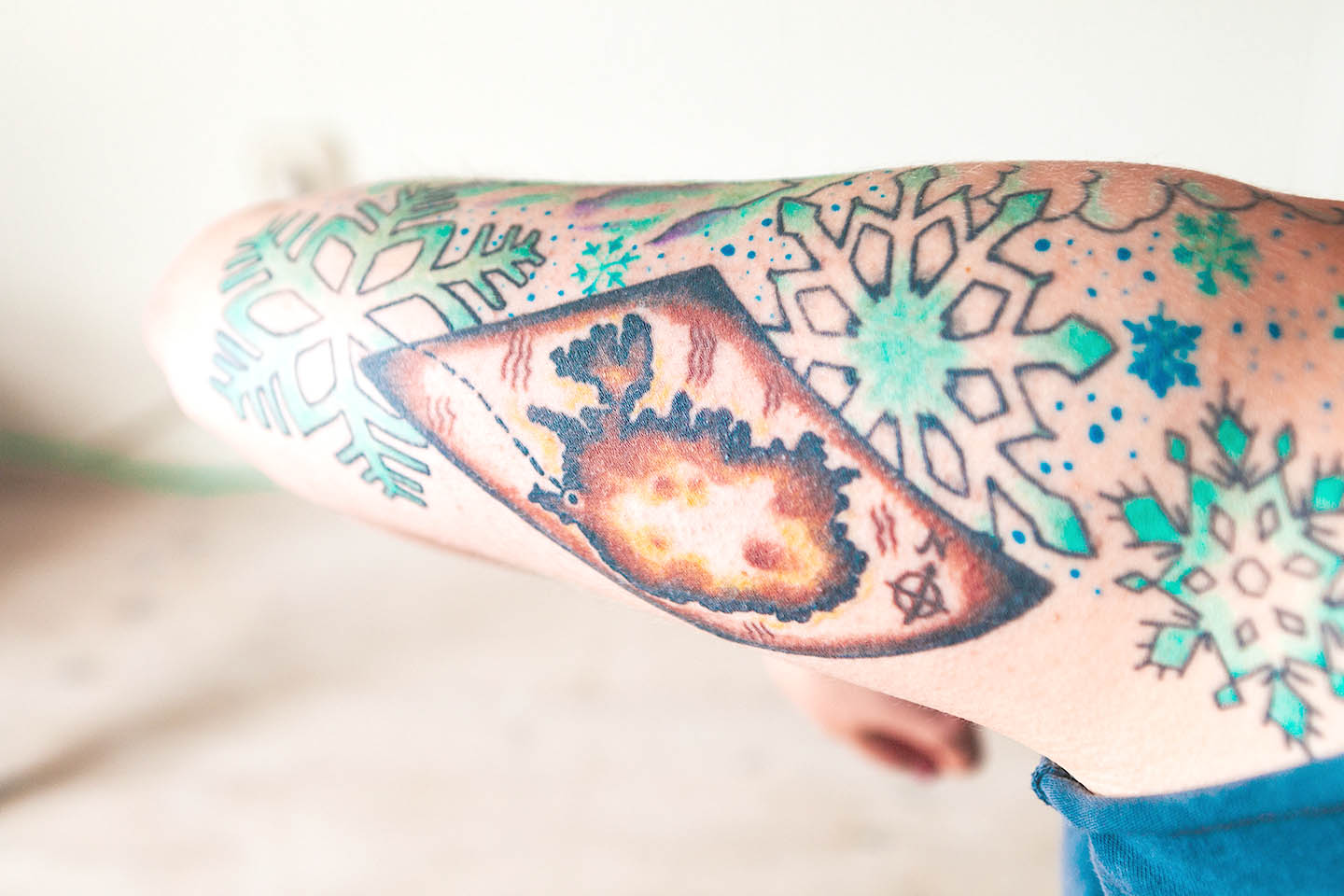
There are a number of suggestions and pieces of advice that can make getting a tattoo a positive and effective experience for you. The following are some of the most crucial pointers and recommendations for tattoo clients:
- Research your artist and shop: Make sure to do your homework about the artist and the store before selecting one. Examine the artist’s portfolio, read customer evaluations, and make sure the store complies with all applicable safety and hygiene requirements.
- Contact your tattoo artist: Before having a tattoo, make an appointment with your tattoo artist. Here is your chance to talk about placement, design concepts, and any worries or inquiries you might have. Your tattoo will be created exactly how you want it thanks to the advice and recommendations of your artist.
- Follow aftercare instructions: Follow aftercare guidelines to ensure that your tattoo heals properly and maintains its wonderful appearance for years to come. Carefully adhere to the aftercare recommendations provided by your tattoo artist, which may include keeping the tattoo hydrated, minimising exposure to sunlight, and not picking at or scratching it.
- Be prepared for some discomfort: Despite the fact that everyone has a varied threshold for pain, it’s crucial to be ready for some discomfort while getting a tattoo.To help manage any discomfort, think about using over-the-counter painkillers or bringing a diversion, like music or a book.
- Communicate with your artist: Tell your tattoo artist if you ever feel particularly hurt or uncomfortable while getting a tattoo. To make the process more pleasant for you, they might be able to make changes.
- Be patient: It takes time to get a tattoo, and it may require several sessions to design and create one. Be patient throughout the process and avoid pressuring the artist to finish a design sooner than is reasonable.
Health risks related to tattoo and how to minimize it?
While getting a tattoo can be a safe and pleasurable way to express oneself, there are certain health hazards involved. The following are a few of the most prevalent health hazards linked to tattoos:
- Infection: One of the major dangers of getting a tattoo is getting infected. When tattooing, bacteria and other pathogens can enter the skin if the tools or surroundings are not properly sterilised. This can result in infections.
- Allergic reactions: Some individuals may experience allergic reactions to tattoo ink. Itching, redness, and swelling are among signs. More severe allergic responses can occasionally happen.
- Scarring: Tattoos may occasionally leave scars, especially if the tattoo artist works too deeply or if the patient has sensitive skin.
- Blood borne diseases: There is a chance of spreading bloodborne illnesses like hepatitis or HIV if equipment is not adequately sterilised.
- Skin problems: Tattoos can occasionally result in skin issues like granulomas (small mounds that can form around the tattoo) or keloids (raised areas of scar tissue).
- MRI complications: In rare cases, tattoos can cause complications during MRI (magnetic resonance imaging) scans.
However there are several steps that you can take to minimize the health risks associated with tattoos:
- Choose a reputed artist and store: Selecting a respectable artist and store is one of the most crucial things you can take to reduce health hazards. Choose a store that follows all relevant safety standards and guidelines, as well as an artist that has a history of using safe and hygienic procedures.
- Pose inquiries: Do not be hesitant to inquire about the shop’s and the artist’s safety and sanitation procedures. Inquire about their methods for sterilising, the types of ink they employ, and the way they get rid of their needles and other tools.
- Check for cleanliness: Verify the shop’s cleanliness by taking a thorough look at it to make sure it is tidy and well-kept. Ensure sure the artist wears gloves and uses brand-new needles for each client, and that all the equipment is thoroughly sterilised.
- Taking good care of your tattoo: Minimizing the health risks connected with tattoos requires proper aftercare. Carefully adhere to the aftercare recommendations provided by your tattoo artist, which may include keeping the tattoo hydrated, minimising exposure to sunlight, and not picking at or scratching it.
- Be wary of possible adverse reactions: Although unlikely, some persons may have an allergic reaction to the ink used for tattoos. The symptoms of an allergic reaction include redness, itching, and swelling; be aware of these symptoms and get medical help if necessary.
- Think about your personal health: Tattoo-related consequences may be more likely in people with weak immune systems, diabetes, or other medical issues. Before getting a tattoo, check with your doctor to make sure it’s safe for you.
By taking these steps to minimize health risks associated with tattoos, you can enjoy your tattoo safely and with peace of mind.
Tattoo Aftercare
For your tattoo to heal properly and maintain its aesthetic appeal for many years to come, proper maintenance is crucial. Here are some crucial advice on tattoo aftercare:
- Follow the advice of your artist: Your artist will give you unique aftercare instructions based on the type of tattoo you have and your skin. Be sure to properly follow the directions, which include keeping the tattoo hydrated, limiting exposure to the sun, and not picking or scratching it.
- Keep the tattoo clean: Maintain the tattoo’s cleanliness by gently washing the region for the first few days after obtaining it with lukewarm water and a mild, fragrance-free soap. Abrasive materials and vigorous scrubbing are not recommended.
- Use lotion or ointment: Your tattoo artist could advise using lotion or ointment to keep the tattoo hydrated and help it heal. Utilize only the items that your artist has prescribed, and refrain from using too much since this may result in clogged pores or other problems.
- Avoid direct sunlight: Avoid exposure to direct sunlight for the first few weeks after receiving a tattoo because this might result in fading and damage. Cover the affected region with clothing or a bandage if you must be in the sun.
- Don’t scratch or pick at the tattoo: It can be tempting to scratch or pick at a fresh tattoo, but doing so can harm the region and raise the possibility of infection. As much as possible, keep your hands away from the tattoo, and stay away from wearing tight clothing that can rub against the area.
- Be patient: The healing process for tattoos can occasionally be painful. Throughout the healing process, be patient, and don’t be afraid to ask your artist any questions or voice any concerns.
You can assist guarantee that your tattoo heals properly and maintain its excellent appearance for years by using these aftercare suggestions.
Tattoo Removal
Tattoo removal is the process of removing a tattoo from the skin. There are several methods of tattoo removal, including:
- Laser removal: The most popular and efficient tattoo removal technique is laser removal. The tattoo ink particles are broken up by high-intensity laser beams in this process, and the body’s immune system naturally absorbs and gets rid of the fragments.
- Surgical removal: A tattoo can occasionally be surgically removed. With this technique, the tattooed region of skin is separated from the body by a cut, and the surrounding skin is then stitched back together. This technique, which sometimes results in a scar, is primarily used for minor tattoos.
- Dermabrasion: The top layers of skin are removed with a high-speed brush or wheel in the dermabrasion tattoo removal procedure. This technique might leave scars and is less efficient than laser removal.
- Chemical peels: Another tattoo removal technique, a chemical solution is applied to the skin where the tattoo has been placed. The tattoo ink is removed with the skin when it peels off as a result of the solution. This technique might leave scars and is less efficient than laser removal.
It’s crucial to remember that tattoo removal can be a time-consuming and painful operation, and it might not always be successful. For the greatest outcomes, it’s also crucial to select a qualified and reliable tattoo removal practitioner.
Temporary Tattoos
Temporary tattoos are patterns or images that are briefly affixed to the skin and last from a few days to a few weeks. These are a fantastic alternative for anyone who wish to play around with tattoo designs or do not want permanent ink.
There are several types of temporary tattoos available, including:
- Decals: Using water, decals are a kind of transient tattoo that are put on the skin. Usually constructed of paper or plastic, they are simple to remove with soap and water.
- Henna tattoos: A sort of temporary tattoo made from a natural plant-based pigment, henna tattoos. The intricately patterned dye can be applied to the skin for several weeks.
- Airbrush tattoos: An airbrush gun is used to make these particular temporary tattoos. Special inks are used to spray the design onto the skin, and it can last for several days.
- Temporary tattoo pens: A particular pen that contains temporary ink is used to produce temporary tattoos known as temporary tattoo pens. Drawn directly onto the skin, the pattern can last for several days.
Temporary tattoos are a simple and enjoyable method to try out various tattoo designs without committing to a permanent one. They are also a fantastic choice for people who want to temporarily spice up their appearance for a special occasion or function.
